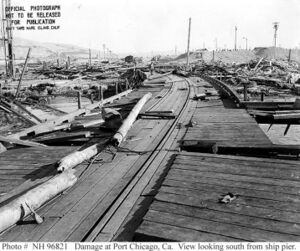Port Chicago disaster (nonfiction): Difference between revisions
(Created page with "thumb|Damage at the Port Chicago Pier after the explosion of July 17, 1944.The '''Port Chicago disaster''' was a deadly munitions explosion...") |
No edit summary |
||
| Line 5: | Line 5: | ||
Most of the dead and injured were enlisted African American sailors. | Most of the dead and injured were enlisted African American sailors. | ||
A month later, unsafe conditions inspired hundreds of servicemen to refuse to load munitions, an act known as the Port Chicago Mutiny. Fifty men | A month later, unsafe conditions inspired hundreds of servicemen to refuse to load munitions, an act known as the Port Chicago Mutiny. Fifty men — called the "Port Chicago 50" — were convicted of mutiny and sentenced to 15 years of prison and hard labor, as well as a dishonorable discharge. Forty-seven of the 50 were released in January 1946; the remaining three served additional months in prison. | ||
During and after the trial, questions were raised about the fairness and legality of the court-martial proceedings. Owing to public pressure, the United States Navy reconvened the courts-martial board in 1945; the court affirmed the guilt of the convicted men. | During and after the trial, questions were raised about the fairness and legality of the court-martial proceedings. Owing to public pressure, the United States Navy reconvened the courts-martial board in 1945; the court affirmed the guilt of the convicted men. | ||
Latest revision as of 09:43, 22 July 2017
The Port Chicago disaster was a deadly munitions explosion that occurred on July 17, 1944, at the Port Chicago Naval Magazine in Port Chicago, California, United States.
Munitions detonated while being loaded onto a cargo vessel bound for the Pacific Theater of Operations, killing 320 sailors and civilians and injuring 390 others.
Most of the dead and injured were enlisted African American sailors.
A month later, unsafe conditions inspired hundreds of servicemen to refuse to load munitions, an act known as the Port Chicago Mutiny. Fifty men — called the "Port Chicago 50" — were convicted of mutiny and sentenced to 15 years of prison and hard labor, as well as a dishonorable discharge. Forty-seven of the 50 were released in January 1946; the remaining three served additional months in prison.
During and after the trial, questions were raised about the fairness and legality of the court-martial proceedings. Owing to public pressure, the United States Navy reconvened the courts-martial board in 1945; the court affirmed the guilt of the convicted men.
Widespread publicity surrounding the case turned it into a cause célèbre among certain Americans; it and other race-related Navy protests of 1944–45 led the Navy to change its practices and initiate the desegregation of its forces beginning in February 1946.
In 1994, the Port Chicago Naval Magazine National Memorial was dedicated to the lives lost in the disaster.
In the News
Fiction cross-reference
Nonfiction cross-reference
External links:
- Port Chicago disaster @ Wikipedia
